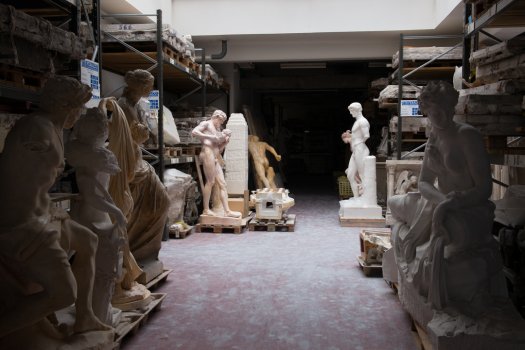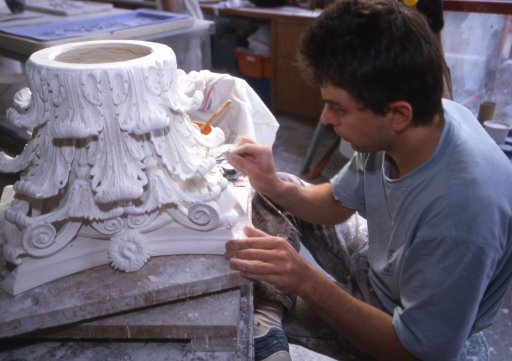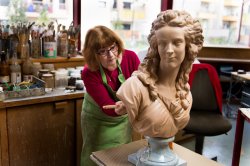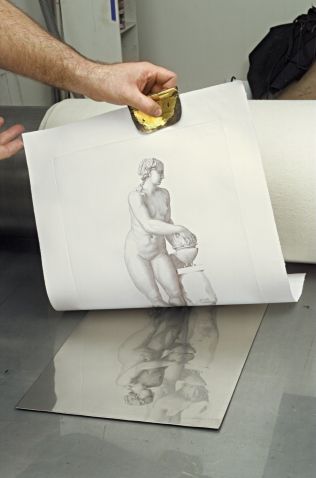The Atelier de moulage du Louvre et des musées de France (casting workshop of the Louvre and museums of France) was created in 1794. Its cast collection gathers sculptures coming from all around the world, from the origins to modern periods. Thanks to the perfection of the reproductions and its renowned savoir-faire in the world, the workshop became a remarkable instrument for the exposure of artworks. The workshop was first intended to give to museums and to the Ecoles des Beaux-Arts (fine art grand schools) perfect reproductions of antic masterpieces. The preservation of work casts which disappeared or are irremediably damaged today turned the workshop into a museum. All commercialized casts are stamped by the Réunion des musées nationaux to guarantee the origin and the quality of the making. As the heir of a secular tradition, the casting workshop ensures the quality of the reproductions.
During your visit at the RMN and Louvre museum’s workshops, you will learn more about casting and chalcography techniques. The workshop still uses the original artwork for the imprint or scans the most fragile ones and then creates the model that will be used for the reproduction (plaster, bronze, resin or terra cotta). You will discover the “secrets” of the patina. The patina workshop ensures to restore each work to its original aspect (marble, wood, multicolor, ceramic…). Then, you will wander in the alleys of the storehouse where thousands of artwork casts are stocked. This visit is no longer proposed but you can look at all our art and creation visits.

 Statuary casting is the art of reproducing sculptures thanks to imprints made from the original work. We obtain with different techniques a negative imprint called a mold from which the reproductions are extracted.
Statuary casting is the art of reproducing sculptures thanks to imprints made from the original work. We obtain with different techniques a negative imprint called a mold from which the reproductions are extracted.
Since the beginning, men used negative and positive imprints of the shape to create a multitude of objects (utensils, guns, jewelry) necessary for daily life.
Later, molding technics enabled the transmission and knowledge of the artistic past. So Ancient Rome will spread bronze reproductions of Greek sculptures and multiple of antic sculptures will be found during the Renaissance. Yet, sculptors from Ancient Egypt already played with “contrast effect” such as did Dali, Cesar or Arman.

By exploiting the numerous possibilities offered by the reversal of shapes, the production of multiples and hyperrealism, the art of molding is reconsidered by these artists. So the statuary mold makers try to be as faithful as possible and the closest collaborators of the sculptor creator/artist.
 Settled in La Plaine Saint-Denis, in the same building than the molding workshops, this workshop reproduces, according the traditional techniques of intaglio, engraved plates part of the Louvre’s collection. At the workshop, the printer staff will explain you the intaglio process from the 130,000 original preserved plates. Chalcography (from Greek chalcos, copper and graphia, to write), is an engraving on metal plates. This term also qualifies the location were the engraving plates are stocked. The artist’s engraving must appear on the plate. Yet, a certain number of operations are necessary before casting the ink with a roller in each holes of the plate: striping, cleaning, inking, wiping, printing press, drying.
Settled in La Plaine Saint-Denis, in the same building than the molding workshops, this workshop reproduces, according the traditional techniques of intaglio, engraved plates part of the Louvre’s collection. At the workshop, the printer staff will explain you the intaglio process from the 130,000 original preserved plates. Chalcography (from Greek chalcos, copper and graphia, to write), is an engraving on metal plates. This term also qualifies the location were the engraving plates are stocked. The artist’s engraving must appear on the plate. Yet, a certain number of operations are necessary before casting the ink with a roller in each holes of the plate: striping, cleaning, inking, wiping, printing press, drying.
In 1792, artworks which belonged to the Crown and became the propriety of the Nation are for the first time gathered together. In 1797 is created the National Chalcography to support engraving art and make the most of this collection. When the Réunion des Musées Nationaux (RMN) was created in 1895, the sales management of chalcography was put in place. This activity consists in the edition, the diffusion, and the selling of new stamps from engraved plates of the collection and according the traditional process of intaglio. Collections continue to grow thanks to an acquisition policy of contemporary artists’ works.
Discover other workshops to visit in Paris
Related : Visit the 19M and discover their different workshops.